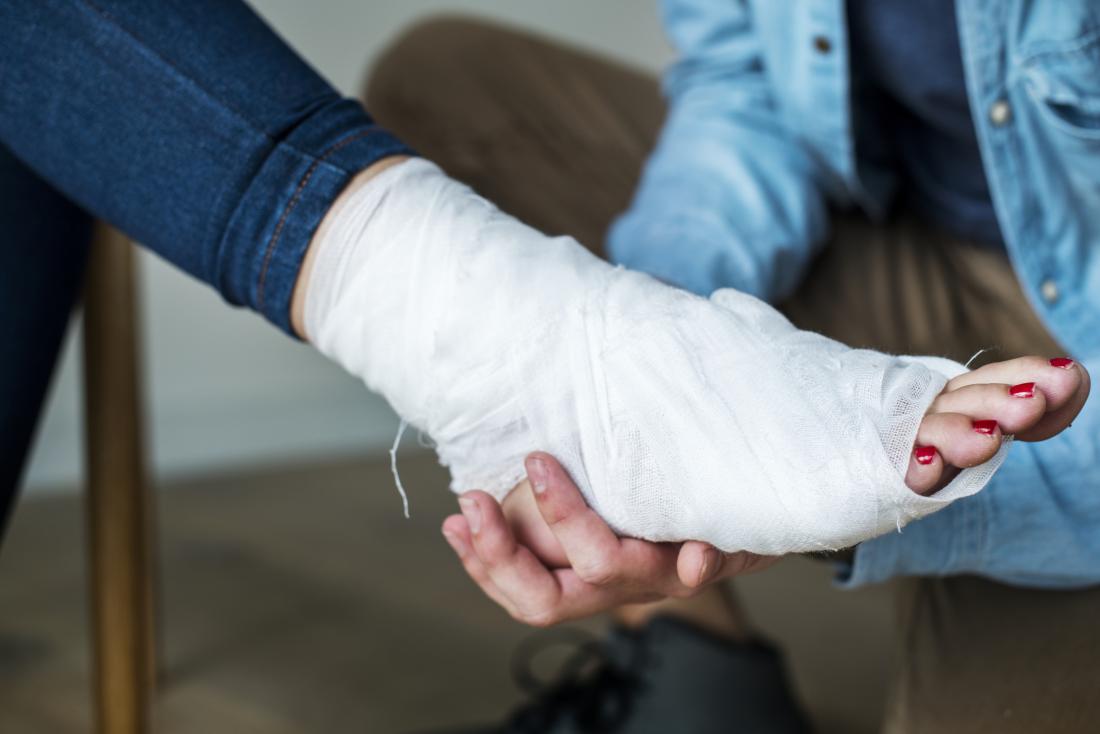A sprain is distinct from a strain. Sprains injure ligaments, while strains affect muscles or tendons.
The symptoms of the two injuries, however, are very similar. For this reason, distinguishing a sprain from a strain without the help of a doctor is difficult.
An ankle sprain can cause intense pain in the joint and may make it difficult to move the ankle or walk. Sometimes, a sprained ankle feels like a broken bone.
Signs and symptoms of a sprained ankle

An ankle sprain causes varying levels of pain, depending on its severity.
The pain and other symptoms an ankle sprain causes vary depending on the severity of the sprain, as well as which ligaments it affects. Some sprains involve multiple ligaments.
Doctors assign a grade of 1, 2, or 3 to sprains depending on their severity:
- Grade 1 sprains are mild and occur when there is stretching and microscopic tearing of the ankle ligament. They typically cause only mild pain and swelling.
- Grade 2 sprains are moderate and occur when the ligament partially tears. They cause moderate pain and swelling. When a doctor manipulates the ankle, they may notice that the joint is abnormally loose.
- Grade 3 sprains are severe and occur when a ligament completely tears. They can cause significant pain and swelling that may make it difficult to move the ankle. When a doctor pulls or pushes on the ankle in certain positions, they may notice joint instability.
Intense pain generally means that there is a more severe sprain, but all sprains can be painful.
Other symptoms include:
- sudden pain, usually after a fall or blow, which may become worse over several hours
- swelling or bruising on or around the ankle
- difficulty moving the ankle
- joint instability that may make it difficult to walk or that causes the ankle to give out or collapse when walking
- a popping sound following the injury (in the case of grade 3 sprains)
A severe sprain may feel like a broken bone. The symptoms may also be similar to a break, including difficulty moving the joint.
People who experience intense muscle or bone pain following an injury should see a doctor.
In children
Some types of sprain are uncommon in children, especially young ones. This is because growth plates, which are areas where bones grow that are near the ends of long bones, are weaker than their ligaments.
Children are therefore more likely to fracture bones than injure soft tissue.
Some symptoms of a sprained ankle in a child include:
- changes in mood or behavior, especially if they are too young to verbalize their pain
- warmth, swelling, or flushing in the joint
- pain in the ankle
- changes in the way the child walks or jumps
- changes in the child’s energy levels
- persistent crying or more frequent attempts to nurse (in babies and toddlers)
- limping
The signs and symptoms of a sprained ankle in a child are similar to those of a broken bone. Caregivers should therefore take a child to the doctor following any serious bone or soft tissue injury.
Causes

Falling over and twisting an ankle is a common cause of sprains.
Any injury that stretches or traumatizes the ligaments can sprain the ankle. Some common causes include:
- Falling: Falling can twist the ankle and the ligaments that support it. People with certain health conditions, such as osteoporosis, are more vulnerable to falls. Sprains from falls during sports such as running are also common.
- A blow to the ankle: A sudden blow to the ankle may sprain the ligaments if the blow forces them to stretch. For example, a person who falls on their ankle may put weight on the ligaments in a way that injures them.
- Sedentary lifestyle: A sedentary lifestyle does not cause sprains, but it may increase the risk of soft tissue injuries. This is because not getting enough exercise can weaken the muscles and soft tissue with time. When a person falls or overextends the ankle, the weak tissue is more likely to tear. Having weak muscles makes it easier for an injury to occur.
- Overuse: Overusing the ankle, such as by playing competitive sports, can cause tiny tears in the ligaments, tendons, or muscles. This increases the risk of injury following a fall or blow and may cause ligament damage that sprains the ankle.
- Previous ankle sprain: An ankle sprain that does not heal correctly may cause another sprain. In some cases, a sprain changes the way a person walks, therefore increasing the risk of additional falls and injuries.
Treatment and home remedies
Treating a sprained ankle begins by keeping the ankle still to prevent future injuries. Controlling swelling may help the pain. Once the initial swelling subsides, gently exercising and stretching the ankle can help it heal while preventing muscle weakness.
Mild sprains may not require medical treatment. A few simple home remedies can help ease the pain associated with these injuries:
- RICE: Rest, ice, compression, and elevation can reduce swelling and pain in the days following the injury. Avoid strenuous exercise and apply ice packs to the affected area for 20 minutes at a time. Apply a bandage or compression sleeve to reduce swelling and elevate the ankle above the heart when sleeping or lying down.
- Over-the-counter medication: Nonsteroidal anti-inflammatory drugs such as ibuprofen can ease pain and reduce swelling.
- Crutches: If the pain is severe, using crutches can help a person remain mobile while staying off of the ankle. This can reduce pain and lower the risk of additional injuries.
If the sprain is severe or home remedies do not work, a doctor may recommend additional treatment, including:
- Immobilization: Wearing a boot or using a splint can prevent the ankle from moving. This improves joint stability and reduces the risk of reinjury.
- Physical therapy: Physical therapy can help heal injured ligaments, as well as surrounding soft tissue that may also have sustained an injury. Physical therapy includes stretches and home exercises, as well as regular evaluation by a physical therapist. Physical therapy will help a person regain motion in the ankle and strengthen the surrounding muscles.
- Exercise: After the initial swelling is gone, a doctor may recommend home exercises or stretches such as ankle circles, toe raises, or heel raises.
- Surgery: Most sprains do not require surgery. If there is instability or damage to more than one ligament, surgery may be required. People with severe injuries, those with complicating conditions such as arthritis, and those who continue to have pain despite physical therapy may require surgery to repair torn ligaments.
When to see a doctor

A child should see a doctor if they have a sprain or other injury.
Many sprains heal without medical treatment, especially if the sprain is minor.
However, only a doctor can accurately diagnose a sprain. This is because sprain symptoms are very similar to those of other injuries and disorders, including bone fractures and arthritis.
See a doctor for a sprain if:
- a child has a sprain or other injury
- the pain is intense or unbearable
- walking is still difficult after 2–3 days
- there is ongoing pain several weeks after a sprain
- a person re-injures their ankle following a sprain
- there is external trauma to the ankle, such as broken skin or bleeding
- a person has chronic pain that lasts for several weeks
- home remedies do not help with the pain, or the pain gets worse with home treatment
Summary
Sprains are common and usually fairly mild, though they can be painful. It is important to take this injury seriously and to rest the ankle to prevent further injury.
A doctor can offer treatment guidelines and ensure that the injury is a sprain and not something more serious.
